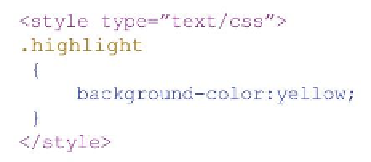HTML and CSS Reference
In-Depth Information
Class name
dot
Figure 3-12: Creating class defi nition.
As you can see, the dot dei nition goes where the element name goes. h e rest is identical to
CSS3 dei nitions for elements. However, implementing a class style is a bit dif erent because it
can be used in almost any element tag.
In order to see how we might want to use a bit of highlighted text, a very handy inline element
is
span
. h e
<span>
tag can be added in the middle of a block element and only change that
part of the content in the
span
container without changing the rest of the block. To add a
class to an element, you use the following format:
<
element class
=
”myClass”
>
Notice that the name of the class does not include the “dot” from the dot dei nition. h e dot is
used only in the style dei nition to let the parser know that the word is a class and not an
element. h e following program (
SpanClass.html
in this chapter's folder at
www.wiley.
com/go/smashinghtml5
) gives you an example of how you might use the class with the
<span>
tag.
60
<!
DOCTYPE HTML
>
<
html
>
<
head
>
<
style type
=
”text/css”
>
body
{
background
-
color
:
#F93;
}
.
highlight
{
background
-
color
:
yellow
;
}
div
{
font
-
family
:
”Comic Sans MS”
,
cursive
;
font
-
size
:
18px
;
}
h1
{
font
-
family
:
”Arial Black”
,
Gadget
,
sans
-
serif
;
color
:
#930;
text
-
align
:
center
;
font
-
size
:
20px
;
}
</
style
>


























